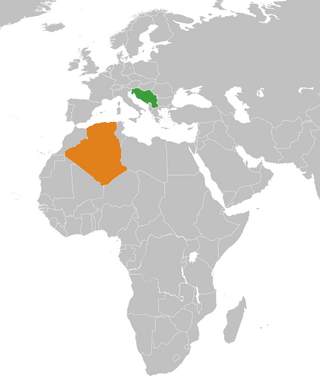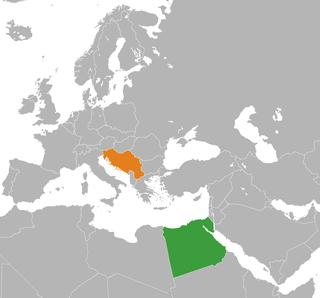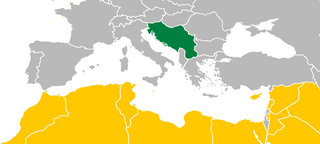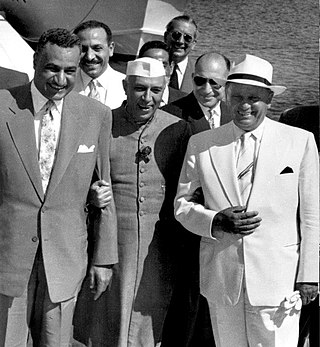
The Non-Aligned Foreign Ministers Conference was held in Georgetown, Guyana from 8 August to 12 August 1972.
Company Path Garden is a small garden on the west side of the Avenue of the Republic in Georgetown, Guyana, between Church and North Streets. During colonial times, “company path” was the name given to a road used by the propertied class as an access road from the river to their lands. The company path, in this case, extended from the side of the Demerara River along the path on which the Bank of Guyana was built and eastwards beyond the Avenue of the Republic.

The Socialist Federal Republic of Yugoslavia was one of the founding members of the Non-Aligned Movement. Its capital, Belgrade, was the host of the First Summit of the Non-Aligned Movement in early September 1961. The city also hosted the Ninth Summit in September 1989.

Democratic Republic of the Congo–Yugoslavia relations were historical foreign relations between Congo-Léopoldville or Zaire and now split-up Socialist Federal Republic of Yugoslavia. Formal diplomatic relations between the two countries were established in 1961, and the two maintained embassies in each other's capitals.

Indonesia–Yugoslavia relations were historical foreign relations between now split-up Socialist Federal Republic of Yugoslavia and Indonesia. Both countries were founding member states of the Non-Aligned Movement. Two countries established formal diplomatic relations in 1954. First diplomatic documents were exchanged as early as 1947. Breakup of Yugoslavia, one of the founding and core members of the Non-Aligned Movement, brought into question the very existence of the Movement which was preserved only by politically pragmatic chairmanship of Indonesia.

Afghanistan–Yugoslavia relations were historical foreign relations between Afghanistan and now split-up Socialist Federal Republic of Yugoslavia. Both countries were founding members of the Non-Aligned Movement. Afghan Prime Minister Daoud Khan represented the Kingdom of Afghanistan at the 1961 First Conference of Heads of State or Government of the Non-Aligned Movement in Belgrade.

Algeria–Yugoslavia relations were historical foreign relations between Algeria and now split-up Socialist Federal Republic of Yugoslavia. Both countries self-identified with the wider Mediterranean region and shared membership in the Non-Aligned Movement. During the Algerian War Yugoslavia provided significant logistical and diplomatic support to the Algerian side which affected its intra-European relations with France. Yugoslavia was the first European country to openly support the FLN.

Egypt–Yugoslavia relations were historical foreign relations between Egypt and now break-up Yugoslavia. Both countries were founding members and prominent participants of the Non-Aligned Movement. While initially marginal, relations between the two Mediterranean countries developed significantly in the aftermath of the Soviet-Yugoslav split of 1948 and the Egyptian revolution of 1952. Belgrade hosted the Non-Aligned movement's first conference for which preparatory meeting took place in Cairo, while Cairo hosted the second conference. While critical of certain aspects of the Camp David Accords Yugoslavia remained major advocate for Egyptian realist approach within the movement, and strongly opposed harsh criticism of Cairo or proposals which questioned country's place within the movement.

India–Yugoslavia relations were historical foreign relations between India and now split-up Socialist Federal Republic of Yugoslavia. Yugoslavia established full diplomatic relations with India on 5 December 1948 following the 1948 Tito–Stalin split. Initially two countries developed their relations at the UN Security Council in 1949 during their shared membership. In the period of the Cold War both countries were the founders and among core members of the Non-Aligned Movement.

Morocco–Yugoslavia relations were historical foreign relations between Morocco and now split-up Socialist Federal Republic of Yugoslavia. Two countries established formal bilateral relations on 2 March 1957. Both countries were founding members of the Non-Aligned Movement. Moroccan king Hassan II supported Yugoslav bid to host the first conference of the movement in 1961 even over the candidacy of Cairo. The belief was that Yugoslav bid will “increase the possibility of wider Arab participation” irrespective of some internal divisions. Yugoslav diplomacy on its part gave high priority to country's relations with non-bloc Mediterranean countries.

Summit Conference of Heads of State or Government of the Non-Aligned Movement on 1–6 September 1961 in Belgrade, Yugoslavia was the first conference of the Non-Aligned Movement. A major contributing factor to the organization of the conference was the process of decolonization of a number of African countries in the 1960s. Some therefore called it the ″Third World's Yalta″ in reference to 1945 Yalta Conference.

Third Conference of the Non-Aligned Movement on 8–10 September 1970 in Lusaka, Zambia was the third conference of the Non-Aligned Movement. A preparatory meeting of Foreign Ministers drafted a number of resolutions which were considered by the Summit Conference. President of Zambia Kenneth Kaunda opened the conference by underlining non-alignment as "the natural choice at the time of increased hostility created by ideological conflicts in the bipolar world"

The Non-Aligned Movement (NAM) is a forum of 120 countries that are not formally aligned with or against any major power bloc. It was founded with the view to advancing interests of developing countries in the context of Cold War confrontation. After the United Nations, it is the largest grouping of states worldwide.
Second Summit Conference of Heads of State or Government of the Non-Aligned Movement on 5–10 October 1964 in Cairo, United Arab Republic (Egypt) was the second conference of the Non-Aligned Movement which followed the Belgrade Conference of 1961 and preceded the Lusaka Conference of 1970. The city of Cairo was selected as a host of the summit conference at the preparatory meeting held in Colombo, Ceylon, on March 23, 1964. At the beginning of the conference the chairmanship of the Movement was transferred from the President of Yugoslavia Josip Broz Tito to the President of Egypt Gamal Abdel Nasser.

6th Summit of the Non-Aligned Movement took place on 3–9 September 1979 in Havana, the capital city of Cuba. 93 countries took part in the summit. It was the first NAM summit which took place in one Iberoamerican country. The event was marked by political and ideological divisions among the non-aligned countries. The organizer wanted to use the event to propose "a natural alliance" between the movement and the Eastern Bloc causing strong resistance from some members, particularly SFR Yugoslavia. While both Cuba and Yugoslavia were at the time nominally socialist states, they took substantially different position in world politics with Cuba perceiving United States and Yugoslavia perceiving Soviet Union as the main threat to its independence.

The 1987 Mediterranean Non-Aligned Countries Ministerial Meeting held on Brijuni Islands, SR Croatia, SFR Yugoslavia was the second ministerial meeting of the Non-Aligned countries from the Mediterranean region. The meeting restricted the number of participating countries exclusively to the few Non-Aligned nations of the Mediterranean area and as such focused primarily on regional issues. At the time of the meeting the group included Southern Mediterranean and Levantine Arab countries and only three European Non-Aligned countries of Malta, Cyprus and SFR Yugoslavia.
1969 Non-Aligned Movement Consultative Meeting took place in Belgrade, SR Serbia, SFR Yugoslavia on 8–12 July following the Warsaw Pact invasion of Czechoslovakia in August 1968. Non-interventionism was put on the top of the agenda by the host nation while the discussion over the national liberation caused some divisions with Algeria requesting their full participation but only Palestine Liberation Organization being granted the right to participate on equal footing. Algeria in turn blocked Yugoslav proposal to admit countries formally aligned in military pacts but pursuing policy close to non-alignment such as the Socialist Republic of Romania and Czechoslovak Socialist Republic which tried to distance themselves from Soviet led Warsaw Pact and Malaysia, Singapore, Tunisia and Pakistan most of which were part of Western led Baghdad Pact or Southeast Asia Treaty Organization.

The "Josip Broz Tito" Art Gallery of the Nonaligned Countries was an art gallery in Titograd in the Socialist Republic of Montenegro, one of the federal subjects of the Socialist Federal Republic Yugoslavia. It was the only art institution established directly by the Non-Aligned Movement's decision.

The 19th Summit of the Non-Aligned Movement was held in January 2024 in Kampala, Uganda. Out of 120 member states around 90 participated in the summit including 30 heads of state. The event was marked by strong criticism of Israel's actions during the Israel–Hamas war by many participating delegations. It was the first time since 2009 that the NAM summit was organized in Africa and first time since 1998 (Durban) it was organized in Sub-Saharan Africa.

The Brioni Meeting between President of Egypt Gamal Abdel Nasser, Prime Minister of India Jawaharlal Nehru and their host President of Yugoslavia Josip Broz Tito took place on the Brijuni Islands, PR Croatia, FPR Yugoslavia on 19 July 1956. The conference was one of the major initiatives among countries unaffiliated to neither Eastern or Western Bloc on their road to the establishment of the Non-Aligned Movement at the 1961 Belgrade Summit. 120 Yugoslav and foreign journalists followed the meeting.


















